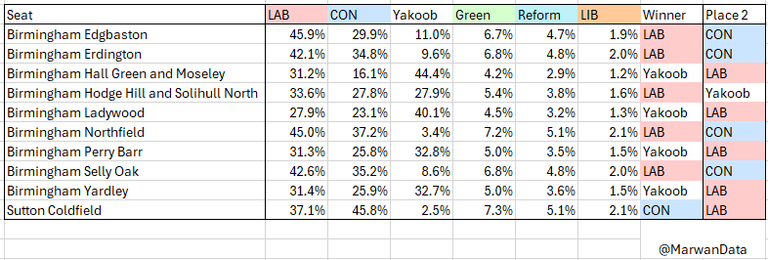MRP stands for Multilevel Regression and Post-Stratification. What they do is first do a standard poll with a large sample - at least 10,000 people rather than 2,000.
They ask for voting intention, and then analyse this by the respondent's characteristics. So say, women in their thirties with a degree vote Labour. Then they use the 2021 census to see how constituencies breakdown by characteristics and use that to predict how constituencies will vote.
So if Constituency A has more women in their thirties with a degree than other types of people, they'll assign it to Labour.
This works in standard elections with about five parties in play. It goes wrong when the number of parties and independents contesting seats expands, because the initial sample misses them.
Here is what YouGov's MRP poll is predicting for Birmingham's constituencies:
Notice the negligible percentages for "Other".
But a month ago we had the West Midlands mayor elections. The votes were counted and declared constituency by constituency. So we have a breakdown of how people actually voted by constituency. Here it is:
Notice the numbers for Yakoob (the independent). The polling for the West Midlands mayor elections completely missed how well he'd do.
Yakoob has decided to stand in the General Election as the candidate for Birmingham Ladywood. The MRP poll for Birmingham Ladywood puts "Other" aka the independent candidate, at 1%. But a month ago in the West Midlands mayor elections, actual voters in Birmingham Ladywood gave him 40.1%.
I think the poll is wrong. And the proliferation of independents this election means the pollsters have likely got other constituencies wrong too.

